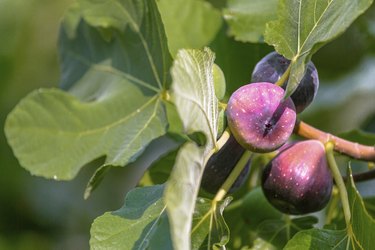
If you want to grow tasty fruits in Arizona, common fig trees (Ficus carica) generally grow well. With its mix of mountain and desert climates, Arizona covers U.S. Department of Agriculture plant hardiness zones 6 through 10a. Figs tend to grow best in the desert areas, but you can grow them in cooler climates if you choose the variety carefully.
Choosing Fig Cultivars
Video of the Day
Fig trees grow in USDA zones 6 through 9, and thrive the desert climates of southern and western Arizona. They are less well suited to the northern and eastern intermountain climates. Figs grow in these areas, but prefer warmer weather and a more Mediterranean-style climate.
Video of the Day
The varieties "Brown Turkey" (Ficus carica "Brown Turkey," USDA zones 7 through 9) and "Black Mission" (Ficus carica "Black Mission," USDA zones 7 through 9) are particularly well suited to Arizona's deserts. "Osborn Prolific" (Ficus carica, "Osborn Prolific" USDA 7 through 9) is one variety that fruits well in cooler climates. To fruit well, all fig trees need full sun for eight to 10 hours a day.
Dealing With Arizona Soils
Fertile, loamy soils are best for figs. If they are planted in sandy soils, they are more likely to suffer damage from nematodes. Figs also require more watering and fertilizer in sandy soils. To minimize these problems, add organic matter to sandy soils by spreading a layer of well-rotted compost 4 inches thick across the soil surface. Mix this in to a depth of 12 inches before planting figs.
In southern Arizona, the caliche layer can can restrict root growth and cause drainage problems. When planting small trees, like figs in locations with caliche, dig the holes 5 feet deep and 5 feet wide and replace the caliche with quality topsoil.
Feeding and Watering Figs
Figs need extra water to produce fruit, especially in desert climates. For the first year after planting, give each tree 10 gallons of water per application, three times a week. After the trees are established they are more tolerant of drought, but for the best fruit you'll need to water 3 to 5 times each week during the growing season. With each watering, soak the soil to a depth of 3 feet. When growing figs in desert climates, water every two weeks in winter.
You can tell fig trees need fertilizer if they put out less than 12 inches of new growth in a year. If you notice growth is slowing, use a fertilizer with an N-P-K ratio of 10-10-10. A fertilizer blend that also contains micronutrients is a good choice. Apply this fertilizer to young trees at a rate of 1/2 pound per application, starting in late winter. For older trees, use 2 to 4 pounds per application. You can fertilize three to five times throughout the growing season, but do not fertilize after the end of July.
Timing Fig Harvests
Most fig trees produce two crops each year in Arizona. The first crop is in early summer, and the second crop in late summer or early fall. In southern Arizona, you'll be harvesting figs in June and then again in August or September. In cooler parts of the state, figs will be ready later than their southern counterparts. If there the weather turns chilly or there is an early fall frost, you might not get a second crop in cooler climates.
You can tell when figs are ready to harvest by their appearance. Most figs turn a black or purple color as the fruit ripens, though some do stay green, depending on the variety. On all varieties, the fruits start to droop as they ripen and they become soft to the touch instead of firm. Ripe fruits come away from the tree easily when you grab the base of the fruit.
Pruning Tips
When pruning fig trees, do not thin the dense inner foliage. The trunk and branches are sensitive to sun, and need the leaves to minimize sun scald. You can prune the top growth and side branches in the late fall or early winter after harvesting the second fruit crop.
If left untrimmed, fig trees will grow more than 20 feet tall with a similar spread. Most respond well to pruning, and you can maintain figs at 10 feet tall and wide. Space fig trees 10 feet apart if you plan on pruning. For larger figs, space up to 25 feet apart.
Disinfect pruning tools before use by soaking them for five minutes in a solution of 1 part bleach to 3 parts water. Rinse with clean water and air-dray before use. Wear gloves when harvesting figs or pruning the trees. The latex produced by fig trees can irritate bare skin. If you do get sap on your skin, wash promptly with soap and water.
- Plant Maps: Arizona Interactive USDA Zone Map
- Sunset: Arizona Climate Zones
- Urban Forest Ecosystems Institute: Edible Fig
- University of Florida IFAS Extension: The Fig
- The University of Arizona Cooperative Extension: Fruiting Fig Well Suited to Desert Landscapes
- The University of Arizona Cooperative Extension: Growing Common Figs in the Low Desert
- Purdue University Cooperative Extension Service: Fig
- Cornell Gardening Resources: Using Organic Matter in the Garden
- The University of Arizona Cooperative Extension: Conquering Home Yard Caliche
- Stark Bros: How to Tell When Figs Are Ripe